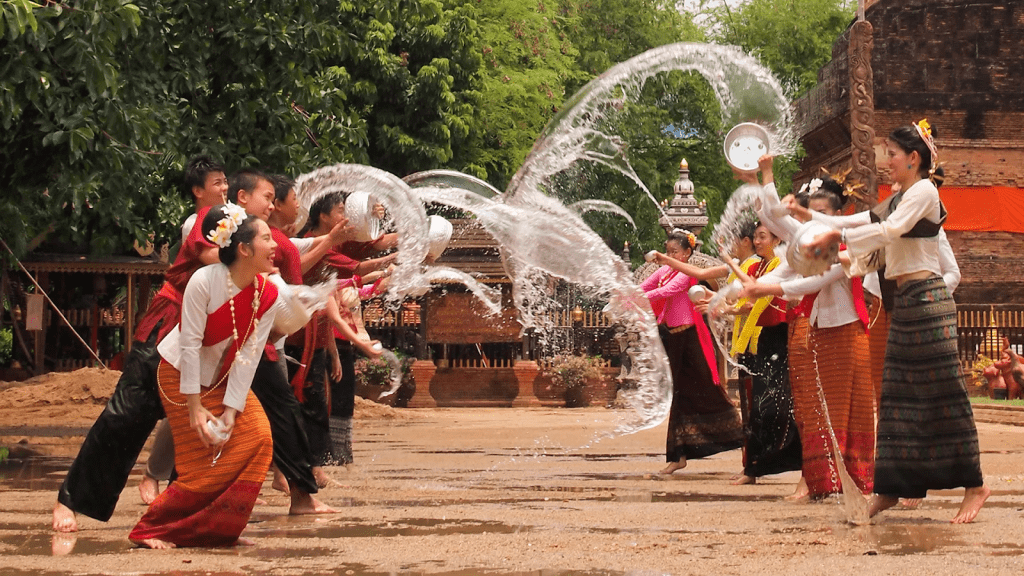Southeast Asia, a region rich in traditions and diverse cultures, celebrates the changing seasons with a variety of festivals. These festivals, which mark the transition of seasons, offer travelers a unique opportunity to immerse themselves in local customs, spiritual practices, and vibrant celebrations. By focusing on the seasonal transitions and the cultural significance of these festivals, travelers can explore the heart of Southeast Asia in ways they never expected. In this article, we will explore five remarkable festivals from Southeast Asia that celebrate the changing of the seasons and provide cultural insights that will enrich your travel experiences.
1. The importance of seasonal festivals in Southeast Asia
Southeast Asian festivals often revolve around key moments in the natural world, such as the changing of the seasons, harvest times, and agricultural cycles. These transitions are deeply embedded in the cultures of the region and provide travelers with meaningful experiences that connect them to the land, people, and traditions.
1.1 Connection between nature and culture
For centuries, Southeast Asian societies have lived in harmony with nature, often depending on the seasons for survival. As a result, seasonal festivals are not just celebrations of nature’s rhythm, but also of agricultural cycles, community bonding, and spiritual reflection.
- Agricultural significance: Many festivals are connected to planting or harvest seasons, celebrating the bounty of the land.
- Spiritual and religious ties: Seasonal changes are often seen as metaphors for life’s cycles: Birth, growth, decay, and renewal – integrating beliefs and rituals that honor deities and spirits.
1.2 Why cultural immersion through seasonal festivals is so special?
Cultural immersion during seasonal festivals offers a richer understanding of local life in Southeast Asia. It allows travelers to experience the things they have never heard before, whether on TV, newspaper, or social media:
- Traditional rituals: Participating in or observing rituals specific to each season.
- Culinary delights: Seasonal foods and drinks that are integral to the festivals.
- Community bonding: The sense of togetherness that defines many of these celebrations.
The following are top five of the most interesting, full of amaze seasonal festivals in Southeast Asia.
2. The Lunar New Year in Vietnam: A celebration of reunion and spring
The Lunar New Year, known as Tết Nguyên Đán in Vietnam, is a vibrant festival that marks the beginning of the lunar calendar. Tết always happens later than the usual New Year, because of the lunar calendar based on the cycle of the Moon. The festival symbolizes the arrival of spring, as well as the reunion of families and friends, and is deeply connected to themes of renewal, family, and honoring ancestors.
2.1 Activities during Tết
- Family gatherings: The Vietnamese return to their ancestral homes to celebrate with family, pay respects to their ancestors, and ensure prosperity for the coming year.
- Traditional foods: Special foods during Tết like bánh chưng (square sticky rice cake), nem (meat filling spring rolls), canh măng (bamboo shoot soup with pork) and xôi gấc (baby jackfruit sticky rice) are prepared and shared during Tết to ensure good luck in the new year. Vietnamese also having mâm ngũ quả (5 different fruits, often are soursop, coconut, papaya, mango as in Southern Vietnam)
- Cultural immersion: Travelers can participate in Tết traditions by joining local families for the New Year’s Eve feast, learning how to make bánh chưng, or visiting a temple to make offerings to ancestors.
- Note for the tourist: Tết is the most significant holiday in Vietnam, typically lasting for up to a week or more. Many businesses, shops, and restaurants close during this time, particularly in the first few days of the festival. Major cities, such as Hanoi and Ho Chi Minh City, may appear quieter as many locals return to their hometowns. Be prepared for limited access during this time of the year in Vietnam. Don’t starve!
2.2 The spiritual significance of Vietnamese Lunar New Year
Tết is a time for spiritual reflection. Vietnamese people believe that the first person to enter the house in the new year brings either good or bad luck. Therefore, rituals are performed to ensure a positive start.
- Tết rituals: People often clean their homes before Tết to sweep away bad luck and bring in good fortune. On New Year’s Eve, families hold an elaborate dinner, followed by prayers to ancestors for blessings in the new year right at the moment new year begins.
- Lucky money: One of the most popular traditions is the giving of “lì xì” (red envelopes with money, usually new money) to children, young adults, and even elders. This practice symbolizes the transfer of good fortune.
3. Thailand’s Songkran: Welcoming the Rainy Season with water
Songkran, celebrated in mid-April (April 13-15), marks the Thai New Year and the beginning of the rainy season. It is one of the most famous festivals in Southeast Asia, characterized by water fights, temple visits, and family rituals. Chiang Mai, Bangkok, and Pattaya have grand celebrations of Songkran.
3.1 Rituals of water and purification
It’s called the Water Festival for a reason – water’s everywhere and it has a significant role in purification.
- Water rituals: The most iconic aspect of Songkran is massive water fights on the streets, symbolizing the washing away of bad luck and people splashing each other with water. This represents the washing away of bad luck and sins. In the temples, people pour water over Buddha statues and on elders to seek blessings.
- Temple visits: Thai people visit temples to pour water on Buddha statues, symbolizing the cleansing of sins and the welcoming of a new year full of blessings. In some regions, people build small pagodas out of sand at temples. These are believed to purify the participants and bring good fortune in the coming year.
- Cultural immersion: Clients can participate in water fights, learn about the religious aspects of Songkran, and enjoy traditional Thai New Year dishes like khao chae (rice soaked in cold water).
3.2 Note for the tourist
Songkran is an exciting and sometimes chaotic festival, particularly in popular tourist cities like Chiang Mai and Bangkok. Be prepared for massive water fights in the streets, and take care of your personal belongings as they could get wet.
- Closed businesses: Some businesses, especially those that are family-owned, may close for a day or two during the festival, as people celebrate with family or go on short vacations. However, tourist attractions and major hotels typically remain open.
- Accommodation prices: During Songkran, accommodation prices may surge due to increased demand, so it’s a good idea to book early.
- Cultural sensitivity: While water fights are a fun way to celebrate, it’s important to respect local customs. For example, avoid throwing water at monks or during religious ceremonies.

4. Cambodia’s Bon Om Touk: Celebrating the end of the Wet Season
The Bon Om Touk, also known as the Water Festival, is a major Cambodian celebration that marks the end of the rainy season and the beginning of the fishing season in Cambodia. This event, held in November, is one of the largest and most culturally significant festivals in the country.
4.1 The boat races and symbolism
- Boat races: The highlight of the festival is the boat races on the Tonle Sap River. Teams compete in long boats decorated with intricate designs, symbolizing the strength and resilience of the people.
- Fireworks and performances: The festival is marked by vibrant fireworks displays and traditional dance performances.
- Cultural immersion: Travelers can enjoy the boat races, visit local communities to learn about their fishing practices, and enjoy traditional Cambodian dishes at food stalls.
4.2 Community bonding
Bon Om Touk is a time when communities come together to celebrate the end of the rainy season and the beginning of the harvest. It’s an excellent opportunity for travelers to experience the communal spirit that defines Cambodia.
4.3 Note for the tourist
Since Bon Om Touk, Cambodia’s Water Festival, is one of the biggest events in the country, there are a few things that travelers should know before taking part in.
- Spectacular boat races in Phnom Penh & Siem Reap: The Tonle Sap River in Phnom Penh hosts grand boat races that attract thousands of spectators. Arrive early to secure a good viewing spot.
- Public transport disruptions: Domestic buses and flights get booked quickly, and travel between cities can be delayed due to heavy traffic.
- Book hotels in advance: Major tourist hubs, including Phnom Penh, Siem Reap, and Battambang, experience a surge in visitors, so early hotel reservations are essential.
- Be mindful of pickpockets in crowds: Large celebrations mean increased risk of theft. Keep valuables secure and avoid carrying large amounts of cash.
5. Laos: Boun Pi Mai – The Lao New Year festival
Boun Pi Mai, or Lao New Year, is a festival celebrated in April to mark the end of the dry season and the beginning of the rainy season in Laos. It is one of the most important cultural events in the country.
5.1 Water, cleansing, and rituals
Lao New Year, celebrated in mid-April with joyful water fights, Buddhist rituals, and vibrant parades. It’s a time for renewal, cleansing, and cultural festivities. The Laotian New Year is centered around purification and renewal, with people seeking blessings for health, wealth, and good fortune in the coming year.
- Water ceremonies: Similar to Songkran in Thailand, Laos celebrates its new year with water. People pour water on Buddha statues and on each other as a way of washing away bad luck.
- Traditional foods and music: The festival features local dishes, dances, and music, with celebrations in the streets and homes across Laos.
- Cultural immersion: Clients can participate in water ceremonies, visit temples, and join in local family celebrations.
5.2 Note for the tourist
- Similar to Songkran – Expect water splashing: Water fights happen everywhere, especially in Luang Prabang and Vientiane. Expect to get wet if you’re in public areas.
- Citywide celebrations & closures: Government offices, banks, and many businesses shut down for the festival. Some tourist attractions may be closed or have altered schedules.
- Visit temples for unique experiences: Locals wash Buddha statues as part of purification rituals, and visitors are welcome to observe or respectfully participate. Monks and elders offer blessings at temples, creating a spiritual atmosphere.
6. How Mango Tiger enhance cultural immersion through Southeast Asian seasonal festivals
Mango Tiger specializes in providing unique cultural immersion experiences that allow travelers to deeply engage with local traditions and festivals. Our itineraries are carefully crafted to ensure your clients don’t just observe but also participate in the festivals that mark the transition of seasons in Southeast Asia.
6.1 Customized festival experiences
We offer tailored travel packages that include participation in seasonal festivals, visits to local communities, and the opportunity to engage with cultural practices. Whether it’s joining in the Songkran water fights or learning how to cook traditional Tết foods, our experiences are designed to connect travelers with the soul of Southeast Asia.
6.2 Supporting sustainable tourism
At Mango Tiger, we promote sustainable tourism by partnering with local communities to provide authentic experiences. Our focus on cultural immersion helps preserve traditional practices and supports local economies, ensuring that your clients’ travels leave a positive impact.
6.3 Expertise in Southeast Asian cultures
With deep expertise in the diverse cultures of Southeast Asia, Mango Tiger provides insights and guidance that allow your clients to gain a deeper understanding of the cultural significance behind each festival. Our knowledgeable local guides ensure an enriching, immersive, and respectful experience.
7. Experience the heart of Southeast Asia through its festivals
Seasonal festivals in Southeast Asia are more than just celebrations—they are windows into the soul of each nation, connecting travelers to centuries-old traditions, deep spiritual beliefs, and the rhythm of nature. Whether it’s the joyful water fights of Songkran and Boun Pi Mai, the sacred family reunions of Tết, or the thrilling boat races of Bon Om Touk, each festival offers an unparalleled opportunity for cultural immersion.
By joining these vibrant celebrations, travelers can go beyond sightseeing and experience @authentic moments of togetherness, tradition, and renewal. However, navigating these festivals can be overwhelming without the right guidance. That’s where Mango Tiger steps in.
With our expertly crafted cultural experiences, sustainable travel approach, and deep connections with local communities, Mango Tiger ensures you don’t just witness these festivals – you live them. From exclusive access to local celebrations to hands-on cultural workshops, we curate journeys that immerse travelers in the heart of Southeast Asia’s heritage.
Let Mango Tiger help you create unforgettable, culturally enriching travel experiences. Contact us today and bring the magic of Southeast Asia’s seasonal festivals to life!

